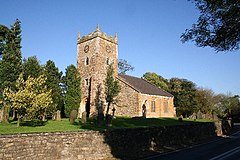|
Burgh on Bain
Burgh on Bain is a village and civil parish in the East Lindsey district of Lincolnshire, England. It is situated on the A157 road, 7 miles (11 km) west from Louth and 7 miles east from Market Rasen. According to the 2001 census it had a population of 114, increasing to 172 at the 2011 census.[1] The parish includes the hamlet of Girsby. Burgh on Bain Grade II listed Anglican church is dedicated to St Helen.[2] Toponomy"Burgh" comes from "burh", meaning fortification, while Bain refers to the River Bain.[3] Archaeology Located on a slope overlooking the Bain Valley is a Neolithic long barrow, marked on maps as a "Tumulus". On the smaller side compared to others found in Lincolnshire, the mound is 27 metres long by 14 metres wide. Today, it is obscured by a cluster of trees and has been burrowed by small animals.[4] In addition, there are several Bronze Age round barrows.[5] Several artefacts have been discovered in Burgh on Bain's fields, such as a polished flint celt and several arrowheads on the grounds of Baxter Square Farm. These have been preserved in Lincoln Museum and Louth Museum.[6] HistoryBurgh on Bain was recorded in the Domesday Book (1086) as part of the wapentake of Wraggoe.[7] Local Bishop's transcripts date back to 1561, while parish records begin in 1575.[3]  There was a manor at Girsby (a medieval settlement),[8] which was owned by the Fox family in the 19th century. It was abandoned before being demolished in the mid 20th century and replaced with a new house.[9] One of Burgh on Bain's Bronze Age round barrows was excavated when RAF Ludford Magna was built in 1942.[10] From the late 1950s to 1991, another round barrow was used as a Royal Observer Corps monitoring post.[5] References
External links
|
||||||||||||||||||||||||||||||||||||

